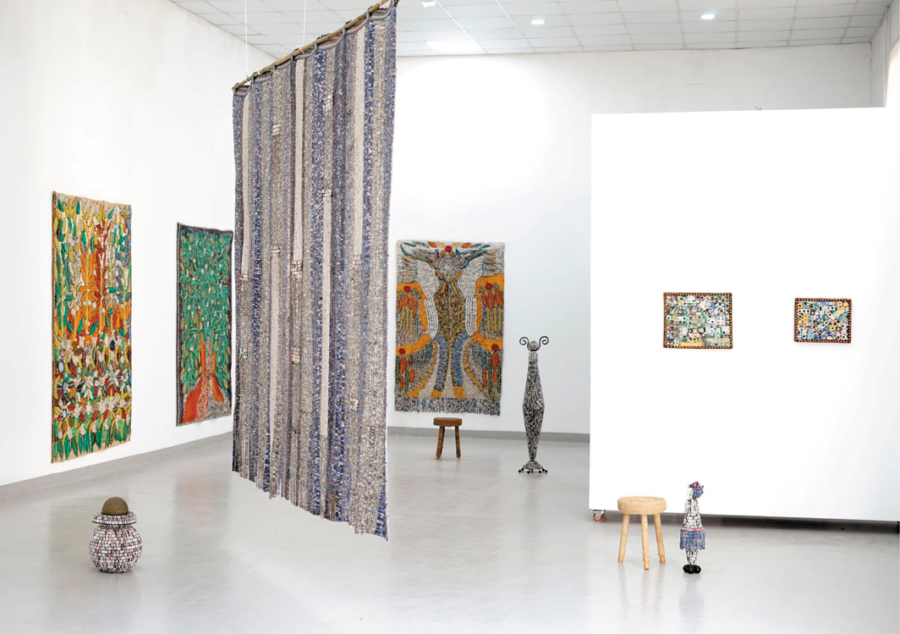May 2022
Download as PDF
View on Artforum

View of “Sanaa Gateja,” 2022. Photo: Emmanuel Ekolu.
Sanaa Gateja is renowned for mural-scale tapestries, which he usually makes by working with more than fifty collaborators in his studio. This was not possible during the lockdowns of 2020, so he shifted to a smaller scale. The exhibition “Radical Care” gathered this new, more intimately sized work alongside a selection of freestanding sculptures and even smaller textiles in a tightly packed display recalling the density of the slums of Kampala, which house up to a million of the capital’s estimated 1.6 million inhabitants. In his “Urban” series, 2021, Gateja takes these informal settlements as his subject. While his perspective is framed from the affluent neighborhood of Lubowa— he depicts the chaos as seen from the top of neighboring hills, making order from disorder—Gateja is concerned with the representation of vernacular and improvised architecture, and of overcrowded organic forms adapted to the morphological and territorial conditions of such sites.
Gateja “paints” using roughly triangular paper beads about three-quarters of an inch long. The color of each bead emerges after it has been rolled. From the sourcing of materials from around the world to the formation of the beads and, finally, the crafting of the sculptural tapestry, each piece is a collaborative effort, with the traces of several individuals’ input clearly discernible. The technique of paper rolling is shared with a number of Ugandan fashion designers as well as craftspeople, although Gateja extends the form beyond material narrative: The pieces on view here embodied the artist’s perspective on reality as experienced in a moment of dreadful change—for instance, the country’s adoption of European Covid-19 measures without taking into account the circumstances of urban settlements such as slums.
Gateja’s experimental pieces in “Radical Care” comprised three layers of fabric. Most pieces in the exhibition were held together by the intricate knitting and mat joinery of the raffia ropes twisted to transform them into surfaces onto which beads could be sewn. With imagery rendered in hyperfine detail, each bead nonetheless enters a zone of nonrepresentation and collaborative practice. Through this process the work connects to ideas of community-based knowledge and intersections of natural, material, and personal transformation.
Furthermore, Gateja’s works draw from vast narratives. The fantastical scenarios capture the broader conversations of ongoing self-reevaluation and environmental calibration in the past two years. Old coffee tree (all works 2021), for example, revisited themes from his earlier work: coffee and bark cloth. The flat style calls to mind icon paintings eschewing central perspective to serve as veils before the threshold to the divine, while swirling colorful beads are placed in patterns recalling the mallet stamps found on cloth made from the mutuba, a tree known to contribute to soil quality. Another towering work, Change 2, was placed at the center of the exhibition and could be apprehended by viewers as they moved from one room to the next. The approximately nine-by-ten-foot installation hung freely; it is transparent, and its draping of predominantly gray and blue lines running vertically from top to bottom could be examined from both sides. The paper materials for this work came from a Democratic field office in Chicago. They include posters, brochures, and leaflets from Barack Obama’s 2008 CHANGE WE CAN BELIEVE IN campaign. The material was to be disposed of after the election but was passed on to the artist by an acquaintance who was familiar with his practice.
The rest of the works in “Radical Care” were wall based. In them, colorful flat flora and fauna forms were stitched over bark cloth, woven-raffia, and banana-fiber surfaces. Biologica showed a giant creature sprouting and firmly standing: an enlargement of a stained microscopic organism that could be in the air, the sea, or the earth. Turning us into active nurseries for nonhumans, these bacteria have the power to radically affect human cultures. Likewise, by scaling down his work, the artist invited viewers into a private and personal contemplation capable of altering our everyday mentality.



